

|
|
|
|
|
|
|
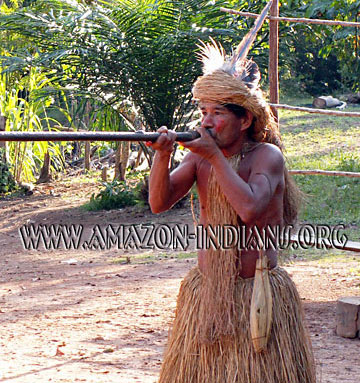
|
|
By John Waymire Photos by Dan James Pantone, Ph.D.
native hunter slowly makes his way through the rainforest. Above, a colony of monkeys busy themselves in the high canopy. The hunter pauses, takes a dart from a quiver, and dips the tip into a curare-loaded resin. He carefully inserts the dart into his blowgun. A large male monkey moves from behind a shielding branch. The hunter takes aim, corrects for variation in his piece, blows, and the monkey tumbles to the ground, hardly noticed by the rest of the colony.
A typical scene from the Amazon rainforest? Hardly. Taking monkey with a blowgun is hard work. Most likely the hunter will have to climb the tree to get off a good shot. When hit, the prey will race through the canopy and the hunter will retreat to the ground and follow on foot until the poison has it way and the monkey stills -- often in the crotch of a branch high above the ground.
Today most hunters prefer the quick work of a 16-ga. shotgun, even though the blast scatters the monkey colony limiting the hunt to a single kill. Along the big river where traders barter with shotgun shells, the Yagua people in the Peruvian Amazon keep their blowguns, called pucunas, stored in the house rafters as family heirlooms. From time to time, boys may take them down to the river's edge and bring back frog or small birds. If the village is located next to where the big tourist boats come, Yagua girls may paddle out to mid-river and attempt to trade toy pucunas for Peruvian soles or if lucky a few American dollars.
Good pucunas are hard to find. I discovered the best way to secure them is to locate a fine craftsman and let him make them for me. I consider pucunas authentic if I saw hunters in the village taking game with the craftsman's handiwork. Family heirlooms should stay where they are. Regional museums are also a source of excellent pucunas and it's all too easy to turn the head of a hungry curator with a few hundred dollars. Honest collectors should let the museum collections remain.
The Yaguas
Yaguas live in Loreto, the Germany-size province in Peru's northeast. Their villages are along the Río Amazonas from bustling Iquitos, the province capital, down river to the frontier at Leticia, Colombia--two days by riverboat. Yagua villages are small, twenty people or so, and the inhabitants wear western clothes but switch into traditional dress on special occasions. In a few isolated Yagua villages up the tributaries, native dress is worn throughout the day
Aside from the traditional clothing, villagers produce a variety of dolls and beadwork and a few craftsmen produce pucunas worthy enough to find their way into a collector's cabinet. A good Yagua pucuna is a unique tool about two meters long and with a good heft and has a crafted look with its thin brown bark wrapping tight along the outside of the shaft.
I was fortunate to sit with a Yagua craftsman, Raphael, as he built two pucunas worthy of a collection. Raphael has skilled hands and often the village calls on them to build a dugout canoe, repair a roof, or make a new spear with steel barbs for a fisherman. For three days, Raphael built his blowguns and I stood at his side. As he worked, he taught me what goes into a quality pucuna.
The first day, though, I thought our session has come to an abrupt end. Raphael disappeared and I was left to wander around the village. Later in the afternoon, Raphael reappeared carrying two wooden planks each about 2x2 inches square. This wood would be heart of his pucunas and it had to be well-seasoned and straight of grain. Raphael went somewhere into the jungle and traded for this wood. He called it pucuna caspi, which means simply blowgun wood and it could come from a variety of trees. The most common pucuna caspi is Iryanthera, a wood with straight grain ideal for blowguns.
The Barrel
Arriving back in the village, Raphael began to immediately fashion one piece of wood into a pucuna. Using a machete and an ancient block plane that he had made himself, he began to round off the corners into something resembling the barrel of a blowgun. Once finished, he smoothed the outside with a small knife. Then using an ancient saw he found somewhere, he carefully cut lengthwise through the piece. Raphael's careful selection of wood allowed him to have two halves nearly identical.
Next, with a tar-soaked snapline, he marked the outline of the bore on each barrel half. He then took a chisel made from a spike nail and began to notch out the bore halves by cutting across the snapline marks. For a hammer he used a steel bar traded from a passing riverboat.
Wrapping the Barrel
With the outline notched, Raphael, using his chisel, began scooping out the chips forming the rough-cut of the bore. He then placed the barrel halves together and had me sight through the bore. Although cut rough, I could see sunlight through the barrel.
In order for a dart to pass through a pucuna barrel with sufficient velocity, the Yagua fashion a gasket from a wad of kapok cotton, Ceiba. Kapok is wrapped around each dart before it’s placed in the pucuna. The seal keeps the air from the hunter's lungs from passing around the dart. This technology demands the pucuna's bore be perfectly smooth so as to not snag the kapok fibers and trap the dart.
To this end, Raphael used a rod made from the pona palm, Socratea, as a finishing tool to smooth the bore. Pona is a rock-hard wood that finds many uses from spears to house floors and is perfect when partnered with wet sand to smooth a pucuna bore. Within minutes of working the pona rod, a sighting revealed a hint of shine within the barrel. Using finer sand, Raphael smoothed the bore to perfection.
With the inside complete, Raphael handed the barrel to his brother, Sebedo, for wrapping. Earlier Sebedo traveled into the jungle and carefully selected vines from the huambe plant, Philodendron solimoesense. Starting from a small cut on the root, he zipped off the vine skins in one long piece. After washing and drying, Sebedo rolled the tape-like skins into a bundle ready for wrapping the pucuna. I noticed each skin was about three-quarter inches in width, ten feet or so long, and fairly flexible. Sebedo's work is important; the quality of the huambe wrapping determines to a large extent the quality of the pucuna.
Being a kind of root, small nodules and spikes cover the skin. To hide these nodules, Sebedo wrapped the skins inside out . The backside of each nodule is now a slight dimple that gives a certain character to the pucuna surface. If the craftsman tries to hurry the process and selects a large mature vine, the nodules will be too large and the huambe skin will not lie flat.
The Missing Copal
In the past, craftsmen adhered the wrapping to the surface of the pucunas with a resin from the copal tree, Protium. They collected copal resin from cuts in the bark then thickened it by boiling. Later the craftsmen could remelt the mass for a variety of sealing and adhesive applications from caulking boats to pucunas.
Today The Yaguas have difficulty obtaining copal and prefer working with common petroleum tar called brea, a material with a lower melting point. Brea is inexpensive and the Yaguas purchase it from passing ships. Brea is black while copal is dark brown. A thumbnail can mark brea. Copal is hard. Burning brea has the odor of petroleum while copal has the wonderful scent of resinous incense. Brea's low melting point is usually not a problem except if one stores the pucuna in direct sunlight where it may get too hot and the adhesive fail. Since hunters use their pucunas in the deep jungle, overheating by sunlight is rare.
I've purchased copal and given it to Sebedo hoping he would make a pucuna the old way. Sebedo told me he prefers brea to copal and that brea is now the traditional adhesive. Once I convinced him to try it on one pucuna and he agreed then burned his hand from dripping copal. Sebedo muttered something under his breath then went back to brea for good.
With the wrapping complete, some Yagua craftsmen coat their pucunas with a stain from the tree they call cumaca or cumala. This tree is probably a variety of Iryanthera and the stain is taken from its inner bark. Once the craftsman applies cumaca, it takes on the sheen of varnish and adds much to the look a finished pucuna.
The mouthpiece of the Yagua pucuna is a large wooden spool-shaped piece usually Maclura tinctoria. After fitting the mouthpiece onto the barrel, the pucuna craftsman sometimes stains it with cumaca or leaves it bare depending on how he cares to mark his handiwork.
The Darts
As the barrel neared completion, other members of Raphael's family helped with the making of the biruta or darts and the basket-like quiver they call the cargajo.
Señor Calluachi took one of the stalks and cuts a section about 10 inches long. The grain of the stalk was very straight and this allowed him to cut lengthwise along the piece freeing up slivers that he smoothed and sharpened into darts. He worked very fast, turning out a dart every minute or so. I tried my hand at dart making and in 15 minutes produced an inferior product. After inspection, Señor Calluachi, with a shy smile, set it aside.
Making the Quiver
Raphael's wife, Sabrina, fashions the quiver basket that holds the darts. She starts by taking palm leaves from the catirina tree that can be either the palm Orbignya or Scheelea, and laying them out on the floor of the house. She cuts the leaves and stitches them together with chambira cord as though she were making a mat. She then rolls up the leaves and gives the bundle a twist that forms it into the characteristic spindle shape of the Yagua quiver. More chambira cord holds it in place. Various species of the tree Erythrina yield a variety of colored seeds for the beadwork.
Often the Yaguas attach a jawbone from the piranha fish to the quiver. The hunter will sharpen the dart’s point with the sharp edges between the teeth.
The poison (ampi) recipes and how they are transported varies between tribes. The curare plant, Chondrodendron tomentosum is the main component of ampi. Hunters crush the roots and stems and render the liquid to syrup to which venoms and other poisons are added. I have seen hunters carry ampi in bamboo cylinders, Bambusa superba. Typically, these poisons and recipes are jealously guarded.
Notes
Duke and Vasquez's book, Amazonian Ethnobotanical Dictionary, CRC Press, has been invaluable in helping me sort out the various local plant names and referencing them into scientific notation. Also Sr. Juan Ruiz, curator at the Universidad Nacional De La Amazonia, has given me much assistance and remained very patient when trying to interpret my notes and sketches.
If you would like to purchase Yagua handicrafts like the kind I have described, please contact me at info@amazon-indians.org. |
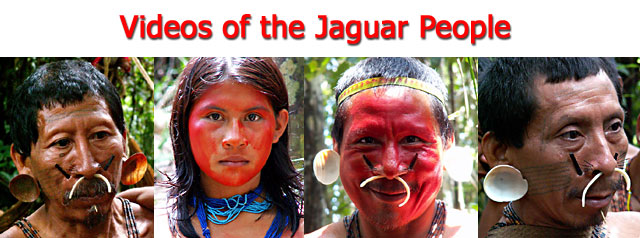
Return to Main Page
|
Previous Page
|
Next Page
|
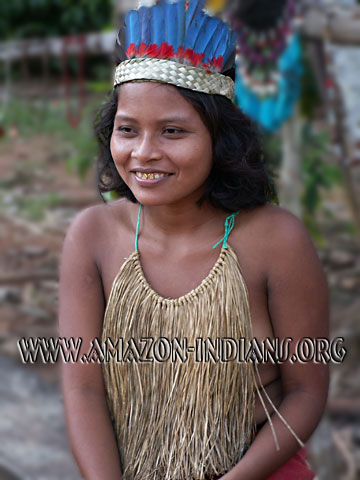 Traditional
dress is the "grass skirt" made from the fiber of the aguaje palm,
Mauritia flexuosa. Other articles include a feathered headdress and ankle
and wristbands with the same design motif as the skirts.
Traditional
dress is the "grass skirt" made from the fiber of the aguaje palm,
Mauritia flexuosa. Other articles include a feathered headdress and ankle
and wristbands with the same design motif as the skirts. 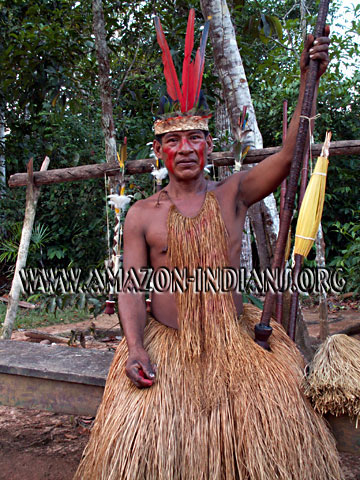 Using his
machete, Raphael cut a number of grooves around the circumference of the barrel
spaced about every six inches. He then tied the barrel halves together with
chambira cord lying in the grooves. Again, the versatile chambira
palm, Astrocaryum, has lent a helping hand to life along the Amazon as it
has for millennia.
Using his
machete, Raphael cut a number of grooves around the circumference of the barrel
spaced about every six inches. He then tied the barrel halves together with
chambira cord lying in the grooves. Again, the versatile chambira
palm, Astrocaryum, has lent a helping hand to life along the Amazon as it
has for millennia.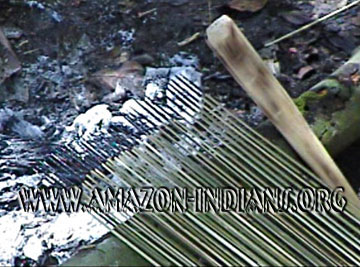 Every one
pitches in. I watched eighty-year old Señor Calluachi whittle darts as he
sat cross-legged on the floor of the family house. Señor Calluachi made his
darts from the inayuga palm, Maximiliana, a plant brisling with
needles, and thorns -- perfect for darts. Some Yaguas use the ribs of the leaves
for the darts, but the Yagua prefer cutting darts from the large stalks that
grow from the trunk.
Every one
pitches in. I watched eighty-year old Señor Calluachi whittle darts as he
sat cross-legged on the floor of the family house. Señor Calluachi made his
darts from the inayuga palm, Maximiliana, a plant brisling with
needles, and thorns -- perfect for darts. Some Yaguas use the ribs of the leaves
for the darts, but the Yagua prefer cutting darts from the large stalks that
grow from the trunk. 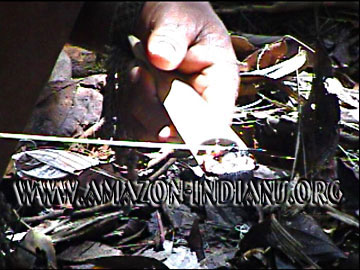 The Yagua use
the chambira palm nut as the container for the kapok cotton. They cut a
hole in the side of the nut, clean out the inside and fill it with the kapok. A
tuff protrudes from the hole ready for the hunter.
The Yagua use
the chambira palm nut as the container for the kapok cotton. They cut a
hole in the side of the nut, clean out the inside and fill it with the kapok. A
tuff protrudes from the hole ready for the hunter.